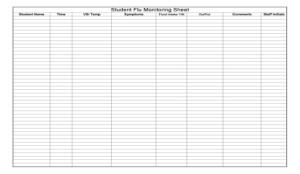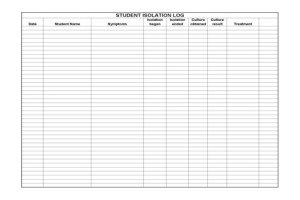Flu recommendations, treatment and procedures
(also see Chapter 8, Infection Control)
These ways to prevent the spread of flu illness should be noted and encouraged at every opportunity. These steps include:
• Cover your cough or sneezes into a tissue or inside of arm, not your hands, dispose of the tissue
• Avoid touching your eyes, nose and mouth
• Wash your hands frequently with soap and water or hand sanitizer
• Stay home if you are sick with fever over 100.4F
• Clean surfaces such as desks, tables, counters, and door knobs with antibacterial solutions
On the occasion that the flu reaches our students these procedures should be followed:
• All students will be observed for the following symptoms: fever above 100.4 F, cough, sore throat, body aches, headache, chills and fatigue
• When these symptoms occur, every effort will be made to isolate the student in their room or a designated infirmary area on campus (to be determined by PD and Head Nurse)
• Staff who are assigned to be with ill students will be provided with N95 masks, gloves and disinfectant wipes
• Observation of symptoms will continue. If the BMC diagnostic criteria for testing is fulfilled or if ordered by the physician, then a nasopharyngeal swab will be obtained and sent to BMC Lab
• MC lab will test the swab for Influenza A virus (results available within 24 hours), if present, a repeat specimen will be obtained and submitted to the State lab for subtyping
• Dr. Dempsey will be notified at which time anti-viral treatment may be initiated according to his orders
• If the testing does not reveal type A flu, isolation is not necessary. However, bed rest may be indicated depending on current symptoms assessed by the nurse on duty.
• Symptomatic treatment by staff and nursing will continue throughout the illness. This may include: Tylenol/ ibuprofen, fluids and rest.
• Documentation of information will be completed by nursing on the Student Isolation Log. This information will be used to follow isolation and testing processes. (see attached)
• Staff will use the Student Monitoring Sheet to record pertinent information for each student in the isolation room. (see attached)
• The Head Nurses at each campus will make daily decisions on the students entering and leaving the isolation infirmary area.
• Updates on available information will be relayed to staff in Community Meetings
• Decisions on limiting travel or visitation on and off campus will be made by the SMT
Supplies to have on hand:
Anti-bacterial wipes
N 95 Masks
Gloves
Tissues
Nasopharyngeal swabs
Ibuprofen/Tylenol
Ginger ale
Sports drink/ other clear fluids
A. Influenza Diagnostic Testing
Specimen kits to collect nasopharyngeal samples for Influenza A and B testing are available from the hospital’s main laboratory. The test detects both A and B disease; results will be available within 24 hours.
More specific testing is available from the State laboratory and will be sent to a referral lab. Each site should keep 2 – 3 kits on hand.
Berkshire Pathology Services will continue to send specimens by request to a reference laboratory for influenza and respiratory pathogen testing. Any respiratory specimens are acceptable for the reference laboratory. Please contact the microbiology laboratory for any questions regarding this or other testing for viral diagnosis.
Influenza
Flu recommendations, treatment and procedures
(also see Chapter 8, Infection Control)
These ways to prevent the spread of flu illness should be noted and encouraged at every opportunity. These steps include:
• Cover your cough or sneezes into a tissue or inside of arm, not your hands, dispose of the tissue
• Avoid touching your eyes, nose and mouth
• Wash your hands frequently with soap and water or hand sanitizer
• Stay home if you are sick with fever over 100.4F
• Clean surfaces such as desks, tables, counters, and door knobs with antibacterial solutions
On the occasion that the flu reaches our students these procedures should be followed:
• All students will be observed for the following symptoms: fever above 100.4 F, cough, sore throat, body aches, headache, chills and fatigue
• When these symptoms occur, every effort will be made to isolate the student in their room or a designated infirmary area on campus (to be determined by PD and Head Nurse)
• Staff who are assigned to be with ill students will be provided with N95 masks, gloves and disinfectant wipes
• Observation of symptoms will continue. If the BMC diagnostic criteria for testing is fulfilled or if ordered by the physician, then a nasopharyngeal swab will be obtained and sent to BMC Lab
• MC lab will test the swab for Influenza A virus (results available within 24 hours), if present, a repeat specimen will be obtained and submitted to the State lab for subtyping
• Dr. Dempsey will be notified at which time anti-viral treatment may be initiated according to his orders
• If the testing does not reveal type A flu, isolation is not necessary. However, bed rest may be indicated depending on current symptoms assessed by the nurse on duty.
• Symptomatic treatment by staff and nursing will continue throughout the illness. This may include: Tylenol/ ibuprofen, fluids and rest.
• Documentation of information will be completed by nursing on the Student Isolation Log. This information will be used to follow isolation and testing processes. (see attached)
• Staff will use the Student Monitoring Sheet to record pertinent information for each student in the isolation room. (see attached)
• The Head Nurses at each campus will make daily decisions on the students entering and leaving the isolation infirmary area.
• Updates on available information will be relayed to staff in Community Meetings
• Decisions on limiting travel or visitation on and off campus will be made by the SMT
Supplies to have on hand:
Anti-bacterial wipes
N 95 Masks
Gloves
Tissues
Nasopharyngeal swabs
Ibuprofen/Tylenol
Ginger ale
Sports drink/ other clear fluids
A. Influenza Diagnostic Testing
Specimen kits to collect nasopharyngeal samples for Influenza A and B testing are available from the hospital’s main laboratory. The test detects both A and B disease; results will be available within 24 hours.
More specific testing is available from the State laboratory and will be sent to a referral lab. Each site should keep 2 – 3 kits on hand.
Berkshire Pathology Services will continue to send specimens by request to a reference laboratory for influenza and respiratory pathogen testing. Any respiratory specimens are acceptable for the reference laboratory. Please contact the microbiology laboratory for any questions regarding this or other testing for viral diagnosis.
Comparative Profiles Of Antiviral Agents For Influenza
| Amantadine | Rimantadine | Zanamivir (Relenza) |
Oseltamivir (Tamiflu |
|
| Influenza Viruses Inhibited |
A | A | A and B | A and B |
| Route of Administration |
Oral (tablet, capsule, syrup) | Oral (tablet, Syrup) |
Oral Inhalation (Diskhaler) |
Oral (Capsule) |
| Usual Adult Dosage |
100mg bid x 5d |
200mg qd or 100mg bid x5d |
100mg bid x5d | 75mg bid x5d* |
| Approved age For treatment |
Greater than 1 year | Greater than 14 yrs | Greater than 7 yrs | Greater than 1 year |
| Approved age for Prophylaxis |
Greater than 1 year | Greater than 14 yrs | Greater than 7 yrs | Greater than 1 year |
| Adverse Effects | CNS side effects; Increased risk of seizures in pts with history of seizures |
CNS side effects (less than with Amantadine | Reduced FEV or peak expiratory flow rate in pts with underlying respiratory disease | Nausea and vomiting |
Student Isolation Log


